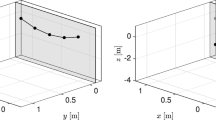Abstract
We introduce a flexible, open source implementation that provides the optimal sensitivity of solutions of nonlinear programming (NLP) problems, and is adapted to a fast solver based on a barrier NLP method. The program, called sIPOPT evaluates the sensitivity of the Karush–Kuhn–Tucker (KKT) system with respect to perturbation parameters. It is paired with the open-source IPOPT NLP solver and reuses matrix factorizations from the solver, so that sensitivities to parameters are determined with minimal computational cost. Aside from estimating sensitivities for parametric NLPs, the program provides approximate NLP solutions for nonlinear model predictive control and state estimation. These are enabled by pre-factored KKT matrices and a fix-relax strategy based on Schur complements. In addition, reduced Hessians are obtained at minimal cost and these are particularly effective to approximate covariance matrices in parameter and state estimation problems. The sIPOPT program is demonstrated on four case studies to illustrate all of these features.
Similar content being viewed by others
References
Wächter A., Biegler L.T.: On the implementation of a primal-dual interior point filter line search algorithm for large-scale nonlinear programming. Math. Program. 106(1), 25–57 (2006)
Fiacco A.V.: Introduction to sensitivity and stability analysis in nonlinear programming. Mathematics in Science and Engineering, vol. 165. Academic Press, Dublin (1983)
Fiacco A.V., Ishizuka Y.: Sensitivity and stability analysis for nonlinear programming. Ann. Oper. Res. 27, 215–236 (1990)
Büskens H., Maurer C.: Sensitivity analysis and real-time control of parametric control problems using nonlinear programming methods. In: Grötschel, M., Krumke, S., Rambau, J. (eds) Online Optimization of Large-scale Systems, pp. 57–68. Springer, Berlin (2001)
Kyparisis J.: Sensitivity analysis for nonlinear programs and variational inequalities with nonunique multipliers. Math. Oper. Res. 15(2), 286–298 (1990)
Kojima M.: Strongly stable stationary solutions in nonlinear programs. In: Robinson, S.M. (eds) Analysis and Computation of Fixed Points, pp. 93–138. Academic Press, New York (1980)
Kojima M., Hirabayashi R.: Continuous deformation of nonlinear programs. Math. Program. Study 21, 150–198 (1984)
Jongen H.T., Jonker P., Twilt F.: Nonlinear Optimization in Finite Dimensions. Kluwer, Dordrecht (2000)
Jongen H.T., Meer K., Triesch E.: Optimization Theory. Kluwer, Dordrecht (2004)
Fiacco, A.V. Ghaemi, A.: A user’s manual for SENSUMT. A penalty function computer program for solution, sensitivity analysis and optimal bound value calculation in parametric nonlinear programs. Technical Report T-434, Management Science and Engineering, George Washington University (1980)
Ganesh N., Biegler L.T.: A reduced hessian strategy for sensitivity analysis of optimal flowsheets. AIChE 33, 282–296 (1987)
Wolbert D., Joulia X., Koehret B., Biegler L.T.: Flowsheet optimization and optimal sensitivity analysis using exact derivatives. Comput. Chem. Eng. 18, 1083 (1994)
Forbes J., Marlin T.E.: Design cost: a systematic approach to technology selection for model-based real-time optimization systems. Comput. Chem. Eng. 20, 717–734 (1996)
Diehl M., Findeisen R., Allgöwer F.: A stabilizing real-time implementation of nonlinear model predictive control. In: Biegler, L.T., Keyes, D., Ghattas, O., van Bloemen Waanders, B., Heinkenschloss, M. (eds) Real-Time PDE-Constrained Optimization, pp. 25–52. SIAM, Philadelphia (2007)
Kadam, J. Marquardt, W.: Sensitivity-based solution updates in closed-loop dynamic optimization. In: Proceedings of the DYCOPS 7 Conference. Elsevier, Amsterdam (2004)
Zavala V.M., Biegler L.T.: The advanced-step NMPC controller: optimality, stability and robustness. Automatica 45(1), 86–93 (2009)
Forsgren A., Gill P.E., Wright M.H.: Interior point methods for nonlinear optimization. SIAM Rev. 44(4), 525–597 (2002)
Guddat J., Guerra Vazquez F., Jongen H.T.: Parametric Optimization: Singularities, Pathfollowing and Jumps. Teubner, Stuttgart (1990)
Robinson S.M.: Generalized equations and their solutions, part II: applications to nonlinear programming. Math. Program. Study 19, 200–221 (1982)
Diehl, M.: Real-Time Optimization for Large Scale Nonlinear Processes. Ph.D. thesis, Universität Heidelberg (2001). http://www.ub.uni-heidelberg.de/archiv/1659/
Zavala, V.M.: Computational Strategies for the Operation of Large-Scale Chemical Processes. Ph.D. thesis, Carnegie Mellon University (2008)
Bartlett R.A., Biegler L.T.: QPSchur: a dual, active-set, schur-complement method for large-scale and structured convex quadratic programming. Optim. Eng. 7, 5–32 (2006)
Fourer R., Gay D.M., Kernighan B.W.: AMPL: a modeling language for mathematical programming. Duxbury Press, Pacific Grove (2002)
Pirnay, H., López-Negrete, R., Biegler, L.T.: sIPOPT Reference Manual. Carnegie Mellon University (2011). https://projects.coin-or.org/Ipopt
Rajaraman S., Hahn J., Mannan M.S.: A methodology for fault detection, isolation, and identification for nonlinear processes with parametric uncertainties. Ind. Eng. Chem. Res. 43(21), 6774–6786 (2004)
Biegler L.T.: Nonlinear Programming: Concepts, Algorithms, and Applications to Chemical Processes. SIAM, Philadelphia (2010)
López-Negrete R., Flores-Tlacuahuac A.: Optimal start-up and product transition policies of a reactive distillation column. Ind. Eng. Chem. Res. 46, 2092–2111 (2007)
Cervantes A.M., Biegler L.T.: Large-scale DAE optimization using a simultaneous NLP formulation. AIChE J. 44(5), 1038–1050 (1998)
Bard Y.: Nonlinear Parameter Estimation. Academic Press, New York (1974)
Author information
Authors and Affiliations
Corresponding author
Rights and permissions
About this article
Cite this article
Pirnay, H., López-Negrete, R. & Biegler, L.T. Optimal sensitivity based on IPOPT. Math. Prog. Comp. 4, 307–331 (2012). https://doi.org/10.1007/s12532-012-0043-2
Received:
Accepted:
Published:
Issue Date:
DOI: https://doi.org/10.1007/s12532-012-0043-2




